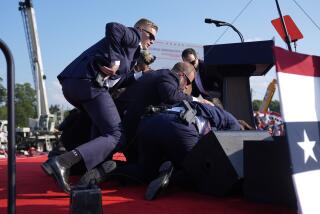Kicking the tires on presidential limousines
DEARBORN, MICH. — The largest collection of retired presidential limousines is ensconced here at the Henry Ford Museum in a frozen-moment procession that begins with Ronald Reagan’s 1972 Lincoln Continental and ends with Theodore Roosevelt’s 1902 horse-drawn brougham carriage. And already, a shameful secret is revealed: Teddy’s two-seater was probably an import.
Barack Obama’s new limo -- a massive, mobile redoubt, a cross between a Cadillac and a hardened missile silo, code-named “Stagecoach” -- will never join this parade.
Some time after Sept. 11, 2001, the Secret Service adopted a policy to destroy presidential limos after they are taken out of service in order to protect their secrets. It’s become routine to replace the presidential limo every four years at the beginning of a new term.
The presidential limo is a vessel of secrets, but here’s what’s thought to be known: Obama’s car is actually one of a fleet of identical and interchangeable vehicles built by General Motors. Judging by its approximate weight (14,000 to 16,000 pounds) and wheelbase, it rides on a modified medium-truck GM chassis.
It’s heavily protected, encased in several inches of military-grade armor, probably composite and possibly what’s called “reactive” armor, to repulse armor-piercing ordnance.
Like armored cars on the civilian market, it almost certainly has a thick woven under-floor blanket made of Kevlar and shock-absorbent materials to ward off grenades that could be rolled under the car. It has ballistic-resistant windows and tires, and a sealed air-circulation system to thwart gas attacks.
And we know that, in comparison with previous generations of presidential limos, “Stagecoach” is seriously ugly, a brute, charmless rectangle of steel and glass that less conveys the grandeur of the office than the withering paranoia of the age. If the sleek, knife-sided elegance of Richard Nixon’s Lehmann-Peterson Lincoln Continental can be compared with the Greek-inspired columns of the Capitol, the new limo is a Bethesda parking garage.
For most of the 20th century, presidential automobiles had to reconcile competing imperatives, the first for safety and the second for symbolism. It’s a testament to a free and stable democracy that its leader can move with relative ease and visibility among its people.
For the president to be transported in an obviously armored car suggests an unquiet nation, a place of putsches and lurking coups. Even at the height of World War II, Franklin D. Roosevelt frequently traveled in his open touring car, a 1939 Lincoln V12 tellingly nicknamed the “Sunshine Special.”
“Franklin felt it was an important part of the job to see the people and be seen,” said Peter Kalinski, assistant curator of transportation for the Henry Ford Museum. The Lincoln -- a K series built on a stretched wheelbase -- has minimal security measures.
There are places for Secret Service agents to stand on the back of the car, and a special compartment for rifles and machines guns. The window glass is thicker than normal but by no means is it bullet-proof. The car was also retrofitted with armor after Pearl Harbor. But by today’s standards -- and with the Zapruder flicker of Dallas forever in our minds -- FDR’s open car seems acutely vulnerable.
The nation was at war. The Secret Service knew there were German spies and saboteurs operating in the U.S. Why didn’t Roosevelt travel in an armored personnel carrier or some kind of tank? Because symbolism trumped security. The Constitution requires that the commander in chief be a civilian; indeed, Americans were fighting the Axis military dictatorships. The theater of the presidency requires that its trappings remain demilitarized.
At the zenith of the American Empire, the 1950s, the presidential parade limo -- a 1950 Lincoln Continental Cosmopolitan -- reflected the nation’s unrivaled power and sense of destiny. To judge by the Lincoln, Dwight Eisenhower’s biggest fear was a rain shower. Or maybe insects. The car was fitted with its distinctive Plexiglas top -- a “bubbletop” -- to keep out the weather, and a folding bug screen to protect the president as he stood in the car during parades. Eisenhower rolled up over 100,000 miles in the Lincoln Bubbletop.
And then there was Dallas. The museum’s most celebrated, if that’s the word, artifact is the 1961 Lincoln Continental in which John F. Kennedy was killed in November 1963. Remarkably, Kennedy’s death car remained in White House service until the Carter administration.
Changed from dark blue to black at President Johnson’s insistence, the limousine -- retrofitted with a fixed roof, heavy armor, thick bulletproof glass and run-flat tires -- doesn’t look much like the car of our collective memory. It’s nonetheless a powerful encounter for visitors.
“It’s not unusual to see people become really emotional,” Kalinski said. “I think a lot of them are surprised that it’s here.”
Why did the Kennedy car get thrown back into the fleet? “These are very specialized cars,” Kalinski said. “It was important to have Johnson out there in public, giving Americans a sense of continuity. They didn’t have time to build a new car.”
The increasingly armor-smothered look of recent presidential limos such as Stagecoach reflects the heightened threat from street-legal weapons such as the .50-caliber Barrett M82 sniper rifle, a monstrous anti-materiel military rifle capable of penetrating the thickest ballistic glass at stand-off distances.
Meanwhile, military anti-vehicle weapons such as rocket-propelled grenades, anti-tank weapons and shaped explosives are easily available on the world weapons market. If terrorists were to score a direct hit on the presidential limo with modern weapons, no amount of armor would save the occupants. Whenever Obama is on the move, he’s vulnerable.
With its see-through windows and hermetically sealed environment, the limo is the “presidential bubble” at its most literal, a zone of unreachable separateness that floats through history. It alienates as it protects. The new president, who had trouble even giving up his BlackBerry, already shows signs of frustration with the security thrown around him.
If I may venture some advice, he needs to sit back and enjoy the ride.
--
dan.neil@latimes.com
Neil is The Times’ automotive critic.






